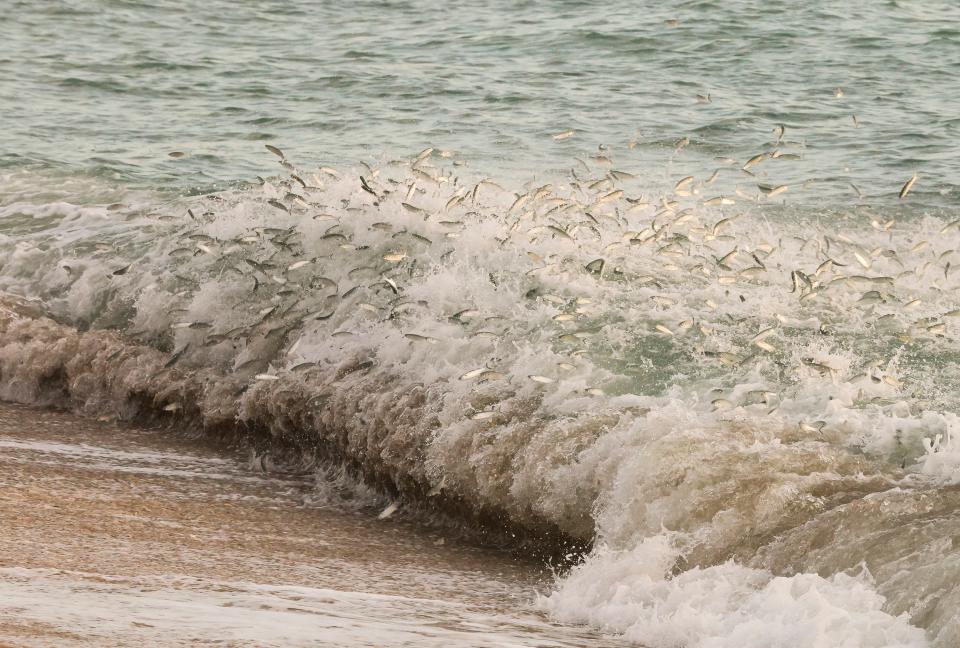Mullet run: What we see in Indian River Lagoon today is far different than pioneer days
The splash was as big as a trawler yacht. The mullet sailed five feet through the air. The small baitfish had to make a choice: fly or become lunch.
A 100-pound tarpon was in hot pursuit. It wheeled 90 degrees on the water's surface. The mullet briefly evaded capture by going airborne. A white frothy foam marked where the giant fish had turned so quickly. A half dozen other mullet streaked away from the spot, no doubt wondering when a predator would target them.
Meanwhile, 75 feet away, a five-pound jack submarined along the surface chasing one of the unfortunate fleeing fish. This mullet swam a straight line at top speed on the surface under the C Dock at the Fort Pierce City Marina. Could it swim fast enough and far enough to outlast the persistent hungry jack? Probably not, was my guess.

The marina was full of life about midday on a recent Saturday. Small schools of finger mullet swam up-tide as it swept in from the ocean a few miles away. They hugged the marina bulkhead for shelter from the myriad predators that patrolled the marina's depths.
Jack crevalle, what locals call "canal tuna," are notorious for their blistering speed and ravenous appetites. Groups of three to six jacks as small as 2 pounds or as big as 15 swam along a few yards from the bulkheads, looking like playground bullies aiming to steal someone's lunch money, or in this case, lunch.
Snook lied out of sight on the marina's bottom. As one of the Indian River Lagoon's top ambush predators, they know they can sit in wait and strike only when the odds of grabbing a meal are decidedly in their favor.
Tarpon roamed the open water of the marina just off the fuel dock between C Dock and M, N and O docks. Any mullet that got chased out into the open by the wolfpack of jacks were fair game for the tarpon and their bucket-shaped mouths. Once in a while, a small goliath grouper that lived in the bulkhead would come out after a mullet running away from a jack.
It was sheer terror for the mullet. Meanwhile, scores of sheepshead, a dozen pufferfish, a moray eel, a school of hardhead catfish and even drifting moon jellies carried on without a care as the feeding period commenced. The finger-long silver mullet, the center of the lagoon's food web, were being singled out by the fish-eaters. Striped (or black) mullet, which are much larger, and look a little different, swam around as if they were enjoying a weekend at the pool.
It was a snapshot of the fall mullet run through the Treasure Coast. Every year, what passes for the change of season here is kicked off by the annual migration of yearling silver mullet. They are no more than a half dozen inches long and come from bays, coves and the lagoon. The mullet gather before they go, and during some unknown tide or moon phase, they begin swimming south. Most exit the lagoon through an inlet and turn south down the beach. Those that don't move south in the lagoon.
Every year, their appearance spurs much debate around tackle shops, on catwalks and jetties and, of course, on social media. People ask where the mullet are. Others take great photos or drone videos for YouTube and Facebook. Even I get emails, texts and tagged in social media posts either reporting where mullet are, or where they aren't.
Anglers are often chasing the schools on foot down the beaches. They cast topwater plugs or swim baits patterned like mullet. Many love fishing the mullet run and hook up with sharks, jacks, snook and tarpon. Others, like my late friend Harry Scherer, used to complain that "fishing during the mullet run is like fishing in a lottery."
My uncle Bob Pelosi, who grew up in the 1950s in Eden along the shores of the lagoon, likes to tell me how "the mullet run was so thick, you could walk across the river on them." Even in my time, I've seen years with tons more mullet than I've seen this year.
Ernie Lyons, longtime editor of The Stuart News, alluded to the mullet's great migration numbers in one of his columns, "The Mullet Plays-When It's Not Fleeing Fish." He described the pods from the 30s and 40s this way:
"The schools of mullet in Florida rivers like the St. Lucie were almost beyond belief in pioneer days. Attacked night and day by the giant tarpon and the sea trout, they took to the air in countless millions and the sound was like muffled thunder."
Will we ever see fall mullet runs like this again? I can only hope.
We have to get the water quality right. Then the seagrass can come back.
Only then will we have a chance to see the thundering hordes of mullet the way the pioneers did.
Ed Killer is a columnist with TCPalm. This is his opinion. Email him at ed.killer@tcpalm.com.
This article originally appeared on Treasure Coast Newspapers: Mullet run in Indian River Lagoon is far different from pioneer days

